Effigy of Richard Beauchamp, Earl of Warwick
Effigy of Richard Beauchamp, Earl of Warwick is in Monumental Effigies of Great Britain.
RICHARD was the son and heir of Thomas Beauchamp, Earl of Warwick, by his wife Margaret, daughter of Lord Ferrars of Groby. He was born at the manor-house of Salwarpe, in the county of Worcester, 28th January, 1381. Richard the Second, and Richard Scroop, afterwards Archbishop of York, were his godfathers. On the coronation of Henry the Fourth, in 1399, he was made a Knight of the Bath. His father dying in 1401, he succeeded to his patrimonial honours and possessions. In 1404 he began to display the knightly character, with which, it will be seen, through life he was so strongly embued, by proclaiming jousts to all comers.



In the following year, he distinguished himself in the battle fought at Usk with the forces of Owen Glendower, in which the son of Glendower was taken prisoner, and the Welch defeated with great loss. Three years after he had the King's licence to leave the kingdom, for the purpose of visiting the Holy Land. In his way he went to Paris, where he was honourably entertained by the King of France. Thence he proceeded into Lombardy, where a herald from one Sir Pandulph Malacet challenged him to joust at Verona, in honour of the institution of the Order of the Garter. On the appointed day he repaired to the lists, where the combat was to take place. The combatants were to tilt with the lance, to fight with axes, and then with swords. Before, however, it came to the trial of swords, poor Sir Pandulph (who had entered the field with affectation of great state, having nine lances borne before him) had had enough of the contest, being severely wounded in the shoulder; and would have been slain, but that the Judge of the Field proclaimed "Peace," and put an end to the fight. From Verona he repaired to Venice, where he was entertained by the Doge, and from thence sailed for Palestine, and accomplished his visit to the Holy City, setting up his arms within the church of the Temple. From the Infidels themselves his great name, and the renown of his ancient house, procured him distinguished attention. Before he returned home he visited Russia, Lithuania, Poland, Prussia, Westphalia, and other countries, in search, like a knight-errant of romance, of chivalrous achievements. He was, indeed, the actual personihcation of the knight drawn by a poet nearly of his own time, Chaucer:
"That from the time that he first began
To riden out he loved chevalrie,
Trouth and honour, fredom and curtesie.
Ful worthy was he in his lordes werre.
And therto had he ridden, none so ferre,
As wel in Christendom and in Hethenesse,
And ever honoured for his worthinesse.
Aboven all nations in Pruce:
In Lettowe had he reyseda, and in Ruce,
.---- and in the Grete See,
At many a nobie army had he be.
At mortal battles had be ben Hfteene;
And foughten for our faith at Tramissene,
In listes thrice, and ay slain his foe."
Note a. Fought; from rixa, strife.
In 1414 he was in an embassy from the English Court to the Council of Constance. There he tilted before the Emperor Sigismund and his Empress. A certain German nobleman challenged him to the for his lady's sake. The German was slain in the unequal trial. The Empress was so struck with Warwick's prowess, that she took the cognizance of his house, the bear and ragged statf, from the shoulder of one of his retainers, and placed it on her own. Warwick, with refined gallantry, sent her the next day the same device richly wrought in pearl. He was next appointed Captain of Calais, made his entry into that fortress in solemn procession, and, true to his chivalric notions, proclaimed a festival of arms. On the appointed day he repaired to the held in a sort of assumed incognito, in imitation of the unknown knights of the old romances. Three French knights in the same spirit accepted his challenge. The first day the Earl of Warwick entered the lists in complete armour, his helmet surmounted by a panache of ostrich feathers, his shield, and the bases of his horse, decorated with the coat of his ancestor the Lord Toney. He was encountered by one of the French knights, who called himself le Chevalier Rouge, whom at the third course he bore out of his saddle, and unhorsed. He then sent him a destrier, or warhorse, as a gift. The next day, with a chaplet of gold upon his helm, wearing the arms of Hanslap, he was met by le Chevalier Blanc, to whom he gave proof of his prowess—smote off his vizor, pierced his armour, and dismounted him. He sent him also a courser. The next day he appeared as Earl of Warwick, quartering Beauchamp, Guy, Hanslap, and Toney, on his trappings. His vizor open, the chaplet on his helm enriched with pearl and precious stones. His opponent was Sir Collard Fynes. At every course he bore him at the point of the lance from his seat. The French spectators thought there was some foul play, and exclaimed that the Earl of Warwick was bound to the saddle. He instantly corrected their error by dismounting from his horse. The third time victor, he recompensed his adversaries with noble gifts, feasted all the company, and returned to Calais.
In 1417 he was with Henry the Fifth in the division of the army under the Duke of Clarence at the storming of the city of Caen, and was the hrst to enter the place and plant the English banner on the battlements.
On the demise of Henry the Fifth he was appointed by will guardian of his son. The Duke of Bedford, Regent of France, dying, he was next constituted Lieutenant General of France and Normandy, and embarked with his wife and son to execute his high ofhce. While at sea they were overtaken by a violent tempest. Destruction seemed inevitable. He caused himself, attired in the tabard of his arms, his wife and son, to be lashed together to the mast of the vessel, in order that, if their bodies should be found, they might be interred together, with that honour which belonged to their noble house. The Earl of Warwick shortly after was taken ill, and died at Rouen. His will is dated August 8th, 1435. By it he gives particular directions for the interment of his body in the collegiate church at Warwick [Map], near his father's tomb; to which church he gives an image of pure gold as a heriot. Four images of gold, each of 20lbs. weight, of himself, holding an anchor in his hands, (allusive, perhaps, to his preservation from shipwreck,) to be offered for him at St. Alban's, Canterbury, Bridlington, and Shrewsbury. The contract between the executors of the Earl, and John Essex, marbler, William Austen, founder, and Thomas Stevyns, coppersmith, for the construction of his tomb, is given at length by the elaborate antiquary Dugdale, who found it among the muniments of the Corporation of Warwick. It is dated 13th June, 32 Henry VI. (1453.) Among the items these may be particularized: "William Austen, citizen and founder, of London, covenanted to cast and make an image of a man armed, of fine latten, garnished with certain ornaments, viz. with sword and dagger, with a garter, with a helm and crest under his head, and at his feet a bear muzzled and a griffin, perfectly made of the finest latten, according to patterns." He was to make also of the finest latten (to be gilded) fourteen embossed images of lords and ladies, in divers vestures, called weepers, to stand in housings (or niches) made about the tomb. A hearse was to be made to stand on the tomb above the principal image. Also certain images of angels and escutcheons of arms. Then follows the particulars of the marbler or mason's work on and about the tomb, and of the glazier for glazing the windows of the new chapel at Warwick, where it was erected, with images and stories after drawings on paper, to be executed in the best glass, not English, but brought from beyond sea, and of the richest colours, "blue, yellow, red, purpure, sanguine, and violet;" no more white, green, or black glass was to be used than was absolutely necessary to express the figures in these
"Storied windows; richly dight;
Shedding a dim religions light."
There are other items of agreement for painting the walls with devices and "imagery," and painting and gilding images of certain Saints. The Beauchamp chapel [Map] and tomb were commenced in 1442, and finished in 1465, at the expense of nearly two thousand five hundred pounds. Of the beautiful figure of Beauchamp (age 53) Mr. Stothard executed four drawings, three of which he etched himself, with a spirit truly worthy of so fine a subject. He ascertained that the ponderous figure of latten or bronze which lay upon the altar-tomb was loose, and with considerable effort succeeded in turning it over, when the armour at the back was found as carefully and accurately represented as in the front, showing all the parts of a suit, its straps and fastenings, with instructive minuteness. This view of the figure about the shoulders is particularly fine, and must be of the the highest value to the historical painter, for its boldness and truth.
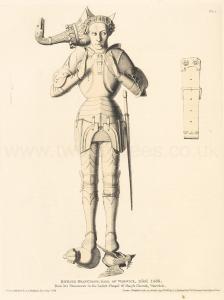
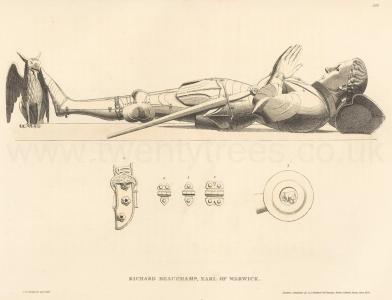
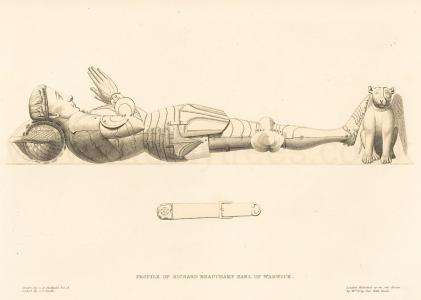
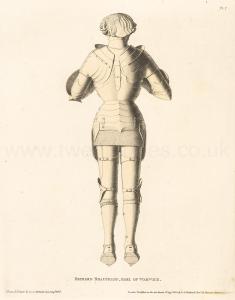
Of the fourteen mourners about the tomb he executed also exquisite drawings in sepia, which it is to be lamented he did not survive to transfer to the copper. These figures stand under their housings, or canopies, five on each side of the tomb, and two at either end. Between these are smaller canopies, each of which is occupied by an angel holding a scroll, inscribed with these words:
"Sit deo laus gloria, defunctis miserecordia." [Praise be to God, and mercy to the dead]
On the south side of the tomb are the following mourners (see the fifth Plate from this tomb:)
1. Richard Nevill, Earl of Salisbury, with a scroll.
2. Edmund Beaufort, Duke of Somerset, husband to Eleanor, daughter of the Earl of Warwick, with a book.

3. Humphrey Stafford, Duke of Buckingham, married to Ann, daughter of Ralph Nevill, Earl of Westmorland, wrapped in his mantle.

4. John Talbot, the great Earl of Shrewsbury, who married Margaret, the Earl of Warwick's elder daughter, in his mantle, the hood drawn over the head, in his hand a book.

5. Richard Nevill, the younger, Earl of Salisbury, husband of Anne the Earl's only daughter by his second marriage, with a book.—At the east end of the tomb.

6. George Nevill, Lord Latimer, with a rosary.
7. Elizabeth, his wife, third daughter of the Earl of Warwick by his first wife, with a book [Note. This is somewhat confusing since Elizabeth Berkeley Countess Warwick was the daughter of Thomas Berkeley 10th and 5th Baron Berkeley, Baron Lisle?].
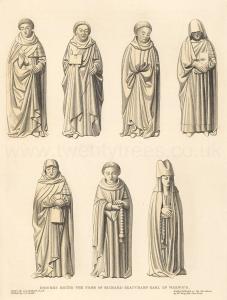
In the sixth plate we have the figures on the north side of the tomb, and at the west end:
1. Alice, daughter of Thomas Montacute, Earl of Salisbury, and wife of Richard Nevill the elder, in her right Earl of Salisbury, with a rosary.
2. Margaret, the Earl of Warwick's eldest daughter by his first wife, and wife of John Talbot, Earl of Shrewsbury, holding in her hand a scroll.

3. Anne, wife of Humphrey Stafford, Duke of Buckingham, daughter of Ralph Nevill, Earl of Westmorland, with a book.

4. Eleanor, wife of Edmund Beaufort, Duke of Somerset, Beauchamp's second daughter by his first marriage, with a rosary.

5. Ann, wife of Richard Nevill, Earl of Salisbury, only daughter of Beauchamp by his second wife, with a book.—At the west end or head of the monument.

6. Cicely, daughter of Richard Nevill, Earl of Salisbury, wife of Henry Beauchamp, with a roll.

6. Henry Beauchamp, the Earl's eldest son, afterwards Duke of Warwick, with a book in a bag.
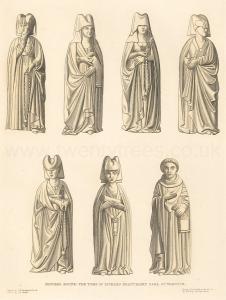
The epitaph on the verge of the tomb runs thus, bears and ragged staves being introduced between the words and sentences as points:
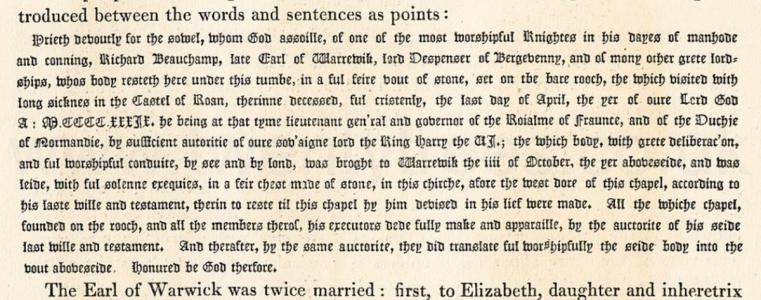
The Earl of Warwick was twice married: first, to Elizabeth, daughter and inheretrix of Thomas Lord Berkeley; secondly, to Isabella, daughter and inheretrix of Thomas Lord Spencer, Earl of Gloucester. By his first wife he had three daughters; by his second, his son and heir, Henry, above mentioned.

